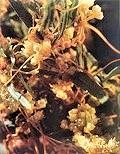Semen Cuscutae
- Name
- Origin
- Where Does It Grow?
- Nature and Flavor
- Identified Active Components / Major Chemical Constituents
- Drug Actions in TCM
- Traditional Uses in TCM
- Pharmacological Actions
- Toxicology
- Administration and Dosage
- Adverse Effect, Side Effects and Cautions
- References
Name
Latin Name: Semen Cuscutae
Common Name: Chinese dodder seed
Scientific Name: Cuscuta chinensis Lam.
Chinese Name: 菟絲子
Pinyin Name: tu si zi
Origin
The ripe seed of Cuscuta chinensis Lam.; an annual voluble parasitic herb of the family Convolvulaceae.1
Where Does It Grow?
Chinese dodder seed is mainly distributed in Jiangsu, Liaoning, Jilin, Hebei, Shandong and Henan provinces of China. 2
Nature and Flavor
Chinese dodder seed is sweet in flavor, warm in nature and manifests its therapeutic actions in the liver, kidney and spleen meridians.1
Identified Active Components / Major Chemical Constituents

Drug Actions in TCM
Chinese dodder seed invigorates kidney, consolidates essence (jing), nourishes liver, improves eyesight, arrests diarrhea and soothes irritating fetus.1Traditional Uses in TCM
Vision problems due to liver and kidney deficiencies
Irritating fetus due to liver and kidney deficiencies
Diabetic symptoms due to kidney deficiency
Tincture made by Chinese dodder seed (whole plant), tropical applying is beneficial to vitiligo.
Modern TCM also uses Chinese dodder seed to boost immune functions, treat chronic urinary and reproductive conditions, prevent aging and cataract.
Pharmacological Actions
Clinical studies
Clinical studies
Clinical studies
Animal studies
Clinical studies
Animal studies
Animal studies
Animal studies
Animal studies
Animal studies
Animal studies
Cell culture studies
Cell culture studies
Toxicology
Administration and Dosage
For decoction, Chinese dodder seed is suggested in 10~15g. The herb is also made in syrup, tincture, pill and powder preparations. 1
Adverse Effect, Side Effects and Cautions
References
- Lui Dai Quan, ed. Chinese Medicine. Shanghai Scientific and Technical Publishers, 2000-6.
- Li Jia Shi, ed. Chinese Medicine Identification. Shanghai Scientific and Technical Publishers, 2000-6.
- Jin Xiao, ed. Study of flavone content in Semen Cuscutae. China Journal of Chinese Materia Medica 1992;17(5):292.
- Guo Cheng, et al. Research on the quality of Semen Cuscutae. China Journal of Chinese Materia Medica 1991;16(10):581.
- Jilin Province Chinese Medicine Research Institute. Botanicals in Chang Bai Shan. Chang Chun, Ji Lin People's Publisher, China 1982:935.
- Ye Pin, et al. Comparison between big Semen Cuscutae and Semen Cuscutae. Proprietary Chinese Medicine 1992;14(3):36.
- Zhao Chungui, et al. Spectrometric analyses of microelements contained in 6 Chinese herbs that soothe irritating fetus. China Journal of Chinese Materia Medica 1990;15(5):43.
- Li Shizhen, Bencao Gangmu (Compendium of Materia Medica)
- Zhou Conghe, et al. Use a essence tonifying decoct to treat 53 cases of chronic prostatitis, Liaoning Journal of Traditional Chinese Medicine 1992;19(3):27.
- Zhou Xiong, ed. To study the effect of Semen Cuscustae decoct on sperm abnormality, Journal of Traditional Chinese Medicine and Chinese Materia Meidca of Jilin 1992;(5):10.
- Zhu Jinfeng, et al. Experimental and clinical studies on the effect of Shou Tai Wan and additives on threatened abortion. Journal of Integrated Traditional and Western Medicine 1987;7(7):407.
- Yan Linmao, ed. Integrating Chinese and western medicine to treat Infantile uterus, Herbal Journal of Traditional Chinese Medicine 1992;14(4):40.
- Jin Xiaodong, et al. Treating 68 cases of chronic bronchitis using kidney tonifying approach, Journal of Traditional Chinese Medicine and Chinese Material Medica of Jilin 1991;(1):11.
- Yang Tao, et al. Effect of Semen Cuscustae on galactose induced cataract in rat. Journal of Beijing Medical University 1991;23(2):97.
- Yang Tao, et al. Effects of four Chinese herbs on the activities of enzymes related to galactose-induced cataract formation. Journal of Biological Chemistry (China)1991;7(6):731.
- Mi Hemin, ed. Comparison study on the bone support and yang strengthening effects of three types of Semen Cuscustae, Chinese Traditional and Herbal Drugs 1991;22(12):547.
- Ding Anrong, et al. Effects of six tonifying medicines on membrane Na+/ K+-ATPase activity in mice. Proprietary Chinese Medicine 1990;12(9):28.
- 18 Jiangsu New Medical College, Pharmacopoeia of Chinese medicine, Shanghai People Hygiene Publisher, Shanghai, China 1997;2006.
- Li Bingru, et al. Effects of kidney tonifying medicine on the function of anterior pituitary-hypothalamus-sex gland axis, Journal of Traditional Chinese Medicine 1984;25(7):543.
- Xiang Pin, et al. Experimental observation of the anti-aging effects of seven Chinese medicines. Liaoning Journal of Traditional Chinese Medicine 1982;6(3):44.
- Duan Xiumei, et al. Researches on Semen Cuscutae botanicals. Research and Development of Chinese medicine in Chang Bai Shan 1992;1(2):53.
- Wu Yiluo. New Compilation of Materia Medica, 1757.
- Quoted in "Wang BX ed. Modern Pharmacological studies on Chinese Medicine. Tianjin Scientific Technology Publishing, 1999: 1248-1250"


